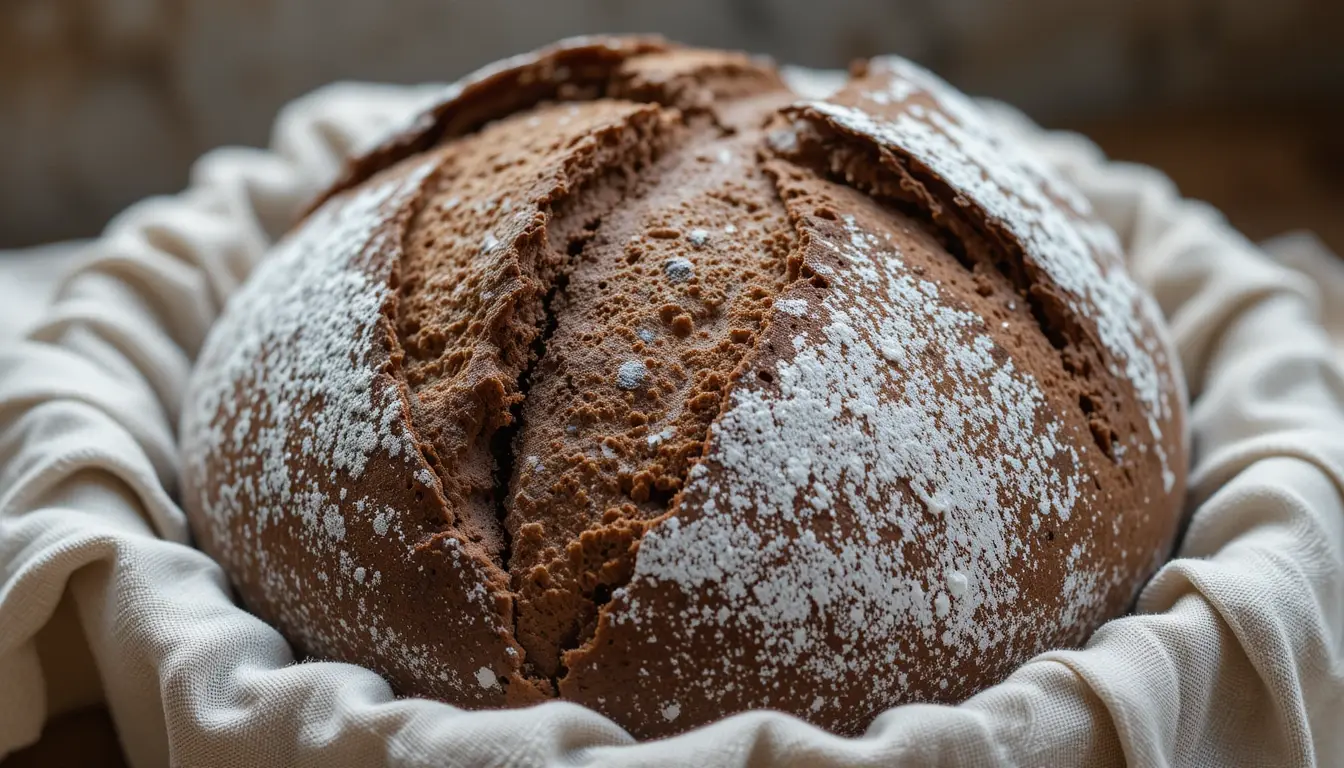Chocolate sourdough bread is a luscious twist on classic sourdough, blending the delicate tang of fermented dough with indulgent cocoa flavors. It bakes up with a subtle sweetness that complements its tender crumb, making it surprisingly versatile for breakfast, brunch, or dessert. In just a few simple steps, you’ll have a beautiful loaf that’s sure to win hearts at any gathering.
Ever wonder why your bread lacks that “wow” factor, even after following every tip in the book? Whether it comes out dense, lacks depth in flavor, or simply doesn’t spark excitement, it can feel like a kitchen mystery you’ll never solve. Fear not—this chocolate sourdough bread recipe is the ultimate solution for adding a new level of richness to your homemade loaves.
In this article, I’ll show you exactly how to harness the natural tang of sourdough and turn it into a velvety cocoa masterpiece. We’ll explore step-by-step instructions, useful tips, and creative variations that make this recipe both foolproof and fun. Ready to upgrade your baking game? Let’s dive in!
Why You’ll Love Chocolate Sourdough Bread
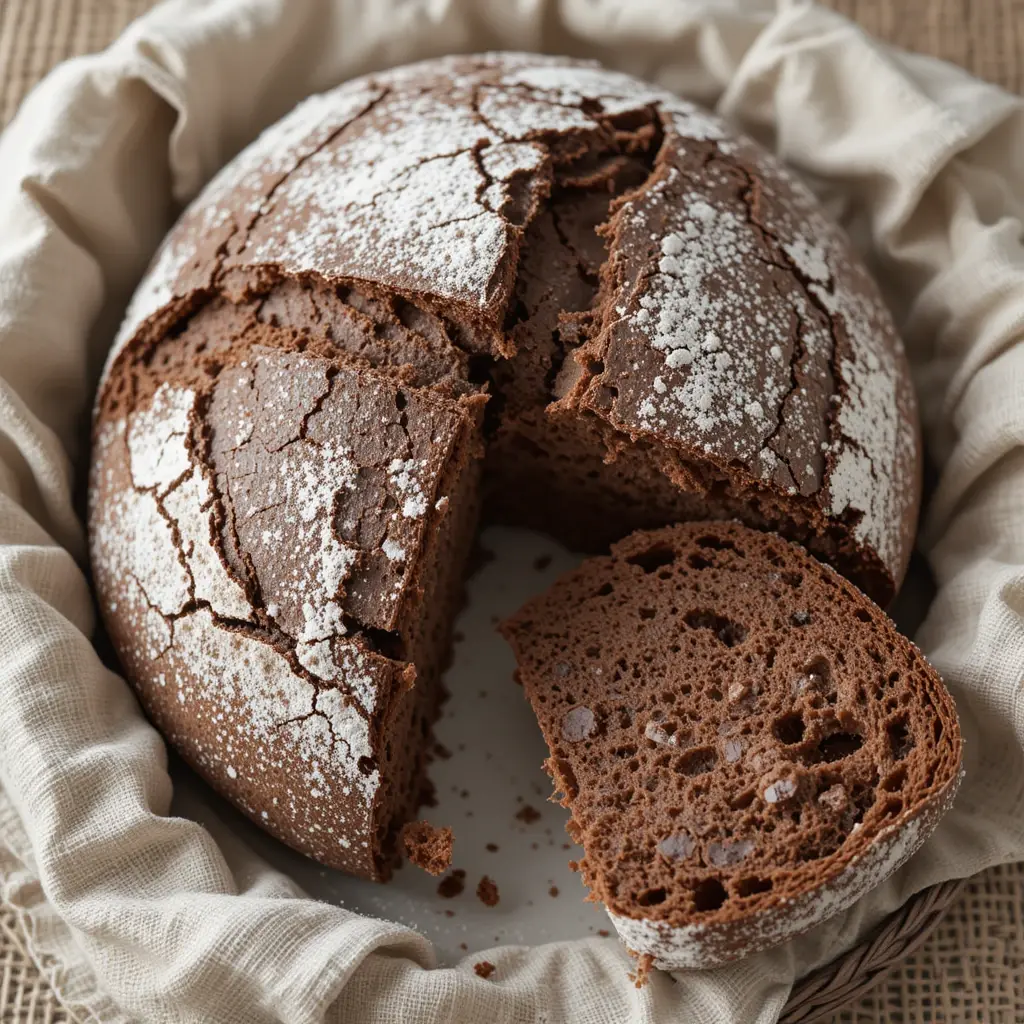
When it comes to baking at home, there’s nothing quite like the smell of fresh bread wafting through the kitchen. Add a chocolatey aroma to the mix, and you’ll find yourself in pure bliss. Chocolate sourdough bread combines the best of both worlds by merging sourdough’s fermented tang with the sweet allure of cocoa. Here’s what makes this bread irresistible:
- Rich Flavor Combo: The subtle sour undertones pair perfectly with chocolate, highlighting the nuanced flavors that emerge from fermenting dough.
- Soft Yet Hearty Texture: Classic sourdough is already known for its chewy crumb. With added cocoa and a touch of sweetness, the interior stays moist and fluffy without feeling heavy.
- Versatility at Its Best: Enjoy a slice at breakfast with a smear of cream cheese, or use it as the base for a sweet sandwich—this loaf can swing sweet or savory.
- Easy to Impress: Despite its bakery-worthy taste, you don’t need to be a professional baker. This recipe walks you through everything from mixing the dough to the final bake.
- Sourdough Health Benefits: According to certain nutrition experts, sourdough fermentation may improve the bioavailability of nutrients and support gut health, though individual results vary. It’s also lower on the glycemic index compared to many store-bought breads.
- Fun to Customize: Whether you’re in the mood for chocolate chip sourdough bread, a “double chocolate” version, or a fruit-infused twist, the possibilities are endless.
Up next, we’ll get into the ingredients that make this loaf so memorable and easy to adapt to your personal taste.
Ingredients for Chocolate Sourdough Bread
Crafting a chocolate sourdough bread recipe doesn’t require fancy or hard-to-find items. You likely have most of these staples on hand already. Here’s what you’ll need for a standard loaf, along with a few optional mix-ins for those who love to experiment:
- Active Sourdough Starter (about 100g): This is the heart and soul of any sourdough. A healthy, bubbly starter ensures a good rise and that signature tang.
- Bread Flour (400g): Offers structure and a chewy crumb. Some people use all-purpose flour, but bread flour’s higher protein content yields better texture.
- Cocoa Powder (30g): Provides the chocolatey foundation. Opt for unsweetened, high-quality cocoa powder for the deepest flavor.
- Warm Water (250–270g): Adjust the amount slightly depending on humidity and your flour’s absorbency. Warm water helps activate the starter.
- Granulated Sugar or Brown Sugar (30g): Balances the cocoa’s bitterness. You can increase or decrease according to taste.
- Salt (8g): Regulates yeast activity and enhances flavor.
- Optional Add-Ins:
- Chocolate Chips or Chopped Chocolate (50–70g) for a chocolate chip sourdough bread vibe.
- Espresso Powder (1 teaspoon) if you want a hint of coffee flair.
- Peanut Butter Swirl for an indulgent chocolate peanut butter sourdough bread twist.
Pro Tip: Feel like spicing it up? Add a pinch of cinnamon or cayenne for a bold, international flair. You can even toss in banana slices for a playful take on sourdough chocolate chip banana bread—just reduce some of the water accordingly if bananas are adding extra moisture.
Now that we have our ingredients sorted, let’s move on to the best part—actually making this indulgent loaf!
How to Make Chocolate Sourdough Bread
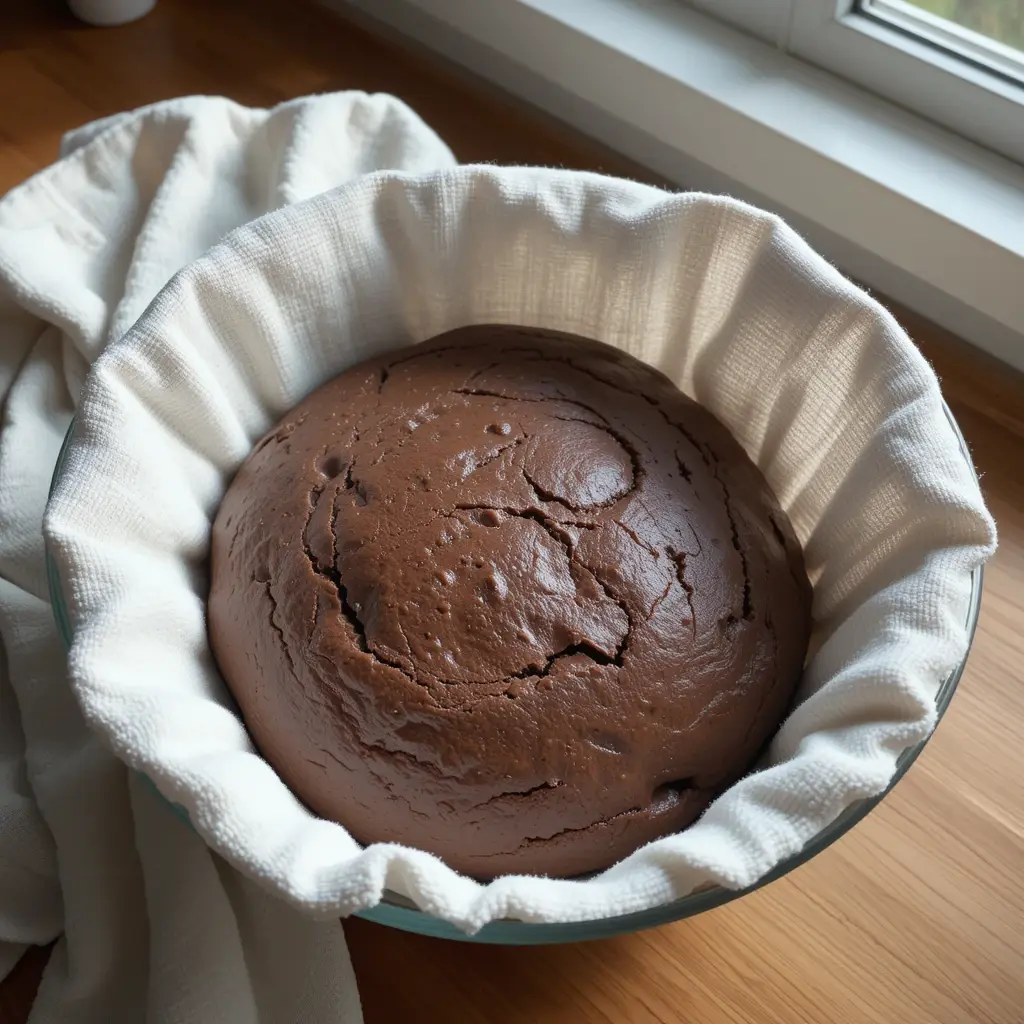
Ready to learn how to make chocolate sourdough bread at home? Let’s break it down step by step. The key is patience and gentle handling of the dough—rushing the fermentation or overworking the gluten can compromise that lovely crumb structure we’re aiming for.
- Activate Your Starter (if needed)
- If your sourdough starter has been in the fridge, take it out and feed it about 8–12 hours before you plan to bake.
- Look for signs of activity: bubbles, a sweet-sour aroma, and some expansion in volume.
- Mix the Dry Ingredients
- In a large mixing bowl, whisk together your bread flour, cocoa powder, sugar, and salt.
- Combine thoroughly so the cocoa powder is evenly distributed.
- Combine Wet and Dry
- Make a well in your dry mixture.
- Add your active sourdough starter and most of the warm water (reserve about 20g to adjust later if the dough feels too dry or too wet).
- Stir until it forms a shaggy dough. If the mixture feels too stiff, add the remaining water a little at a time.
- Autolyse
- Cover the bowl with a damp cloth and let it sit for about 30 minutes.
- Autolysing allows the flour to hydrate and gluten strands to start developing without heavy kneading.
- Knead or Stretch & Fold
- Once autolyse is done, gently knead the dough or use the stretch-and-fold method to build gluten. If kneading by hand, aim for about 5–8 minutes. If doing stretch-and-fold:
- Grab one side of the dough, pull it up, and fold it over the center.
- Rotate the bowl 90 degrees and repeat. Do this 4–5 times per session.
- Rest the dough for 30 minutes in between sets.
- If you’re adding chocolate chips or nuts, incorporate them during the first or second stretch-and-fold session.
- Once autolyse is done, gently knead the dough or use the stretch-and-fold method to build gluten. If kneading by hand, aim for about 5–8 minutes. If doing stretch-and-fold:
- Bulk Ferment
- Cover your dough again and place it in a slightly warm, draft-free spot.
- Let it ferment for about 4–6 hours, or until it has expanded by about 50%–75%.
- Times can vary based on room temperature—colder rooms mean longer fermentation.
- Shape the Dough
- Once the dough has risen sufficiently, gently turn it onto a lightly floured surface.
- Shape it into a round or oval, tucking the edges under to create surface tension.
- Place the shaped dough seam side down into a floured proofing basket or a parchment-lined bowl.
- Final Proof
- Cover and let the dough rest for another 2–4 hours. Alternatively, do a cold retard by placing it in the fridge overnight for an even deeper flavor and easier scoring.
- Score and Bake
- Preheat your oven to 450°F (230°C). Place a Dutch oven or a baking stone inside to heat up for at least 30 minutes.
- Carefully invert the dough onto a piece of parchment if you haven’t already.
- Score the top with a sharp knife or lame, then transfer it to your hot Dutch oven (cover on) or onto the baking stone.
- Bake covered for 20 minutes, then uncover and reduce heat to 425°F (218°C). Bake an additional 15–20 minutes or until the crust is firm and the internal temperature reaches about 200°F (93°C).
- Cool on a rack for at least 1 hour before slicing to lock in moisture and flavor.
Next up, we’ll look into some extra chef-driven insights and fun variations to keep your baking adventures fresh.
Chef Tips and Variations for Chocolate Sourdough Bread
You’ve nailed the basic loaf—now it’s time to fine-tune your technique and experiment with unique twists. Below are some tips and variations to elevate your double chocolate sourdough bread (or any other spin-off you can dream up!).
- Hydration Balance: Because cocoa powder can absorb more liquid, monitor your dough closely. Add water gradually to avoid a stiff loaf.
- Sweet or Savory? This bread works well as a sweet treat with added sugar, honey, or even maple syrup. But if you prefer a milder sweetness, reduce the sugar and rely on the cocoa’s subtle bitterness.
- “Double Chocolate” Upgrade: Throw in chunks of dark or semi-sweet chocolate after the autolyse stage for an ultra-indulgent experience. This transforms your loaf into double chocolate chip sourdough bread, perfect for dessert-like sandwiches.
- Coffee Infusion: For a bolder flavor, dissolve a teaspoon of instant espresso in your mixing water. You’ll get a pleasant mocha undertone, reminiscent of chocolate coffee sourdough bread.
- Add Fruits or Nuts: Dried cherries, cranberries, or toasted walnuts can turn your loaf into a gourmet delight—think of it like a cross between chocolate brownie sourdough bread and fruit-nut bread.
- Discard Variation: Don’t toss that sourdough discard! Incorporate some of it into the recipe for a chocolate sourdough discard bread—just remember to adjust hydration since discard can be more liquid or more stiff depending on your feeding schedule.
- Peanut Butter Swirl: Gently knead a swirl of peanut butter into the dough. This gives you a partial homage to a chocolate peanut butter sourdough bread, reminiscent of chocolate-peanut butter cups.
Up next, let’s talk about how you can serve this bread so that every slice shines.
Serving Suggestions for Chocolate Sourdough Bread
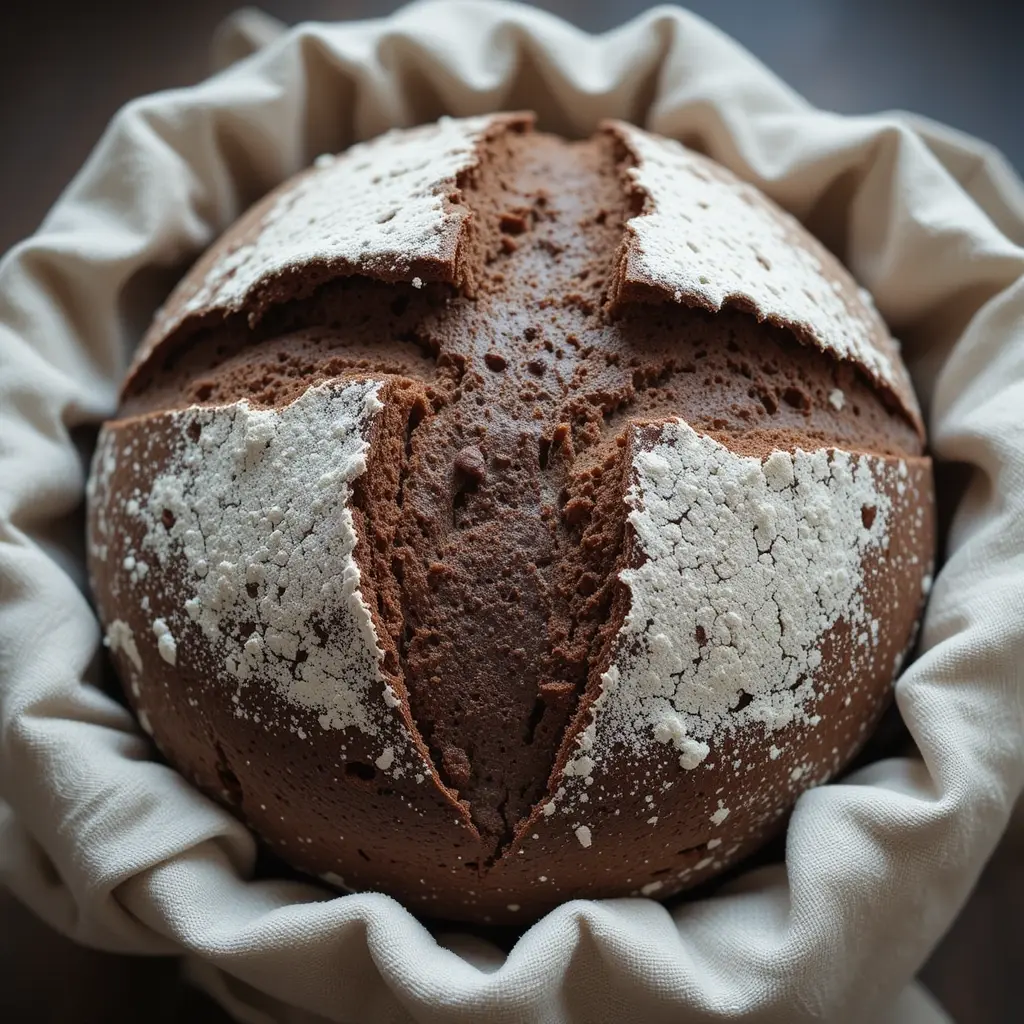
There’s more than one way to enjoy a slice of sourdough chocolate bread. From breakfast spreads to late-night treats, here are some ideas to make the most of your loaf:
- Breakfast Toast: Spread softened cream cheese, almond butter, or plain butter on a toasted slice. Top it off with fresh berries to create a delicious fruity contrast.
- French Toast or Bread Pudding: Turn stale slices into a decadent French toast or a rich bread pudding—cocoa notes pair wonderfully with vanilla custard.
- Gourmet Sandwiches: Elevate a PB&J or try a savory spin by pairing your chocolate loaf with mild cheeses like brie or mozzarella, plus fresh fruit slices.
- Dessert Bruschetta: Drizzle melted chocolate on toasted slices and top with toasted nuts or a sprinkle of sea salt. Finish with whipped cream or mascarpone.
- Accompaniments for Soup or Salad: Surprisingly, the slight sweetness in this bread can contrast well with savory soups or a crisp green salad.
No matter how you slice it, this bread is guaranteed to stand out. In the next section, we’ll cover how best to store and reheat your leftovers for continued enjoyment.
Storing and Reheating Leftovers of Chocolate Sourdough Bread
When you bake a fresh loaf of chocolate sourdough bread, you’ll want to keep it tasting its best for as long as possible. Proper storage and reheating techniques can help maintain both flavor and texture:
- Storage at Room Temperature: Wrap your fully cooled loaf in a clean cloth or a bread bag. This allows it to breathe slightly without drying out. Store it in a cool, dark spot on your countertop for up to 3 days.
- Refrigeration Caution: Bread can stale faster in the fridge. If you must store it longer, slicing and freezing is often a better option.
- Freezing: Slice the loaf and wrap individual slices in parchment or plastic wrap before placing them in a freezer-safe container or bag. They’ll keep well for up to 2 months.
- Reheating: Thaw frozen slices in the fridge overnight or pop them straight into a toaster or preheated oven at 350°F (177°C) for about 5–7 minutes. This revives the crust and warms the crumb without over-drying.
Next, let’s wrap up the essential pointers in one quick overview before diving into FAQs.
More Delicious Recipes to Try
If you loved this chocolate sourdough bread, here are a few more irresistible recipes you’ll want to bake next:
- Sourdough Discard Bagels – A chewy and satisfying way to use up your discard!
- Starbucks Cake Pop Recipe – Perfectly sweet, bite-sized treats you can make at home.
- Blackberry Cheesecake Recipe – A fruity twist on a classic dessert.
- Protein Pudding Recipe – A guilt-free treat with creamy texture and a protein boost.
- Date Nut Bread Recipe – Moist, rich, and perfect with a cup of tea.
- Chocolate Chip Cookie Recipe Without Brown Sugar – Crispy-edged, chewy-centered cookies using only pantry staples!
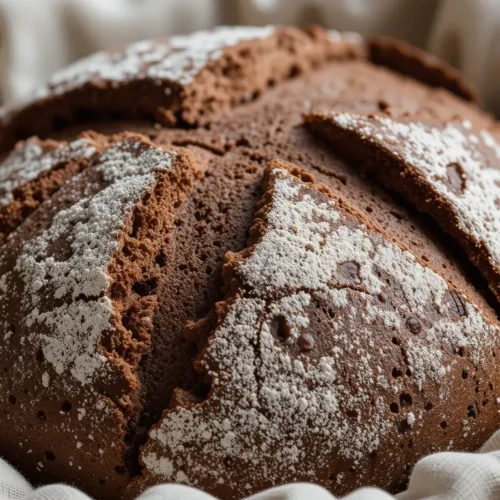
Chocolate Sourdough Bread
Equipment
- Large mixing bowl
- Whisk
- Proofing basket or bowl
- Damp kitchen towel or plastic wrap
- Sharp knife or lame for scoring
- Dutch oven or baking stone
- Measuring scale (recommended for accuracy)
Ingredients
- Active Sourdough Starter: 100g
- Bread Flour: 400g
- Cocoa Powder Unsweetened: 30g
- Granulated Sugar or Brown Sugar: 30g
- Salt: 8g
- Warm Water: 250–270g adjust as needed
(Optional) Chocolate Chips or Chopped Chocolate: 50–70g
(Optional) Espresso Powder: 1 tsp for added depth
Instructions
- Mix Dry Ingredients: In a bowl, whisk flour, cocoa, sugar, and salt.
- Combine with Starter: Add sourdough starter and most of the warm water. Stir to form a shaggy dough.
- Autolyse: Cover and rest for 30 minutes.
- Stretch and Fold (or Knead): Perform 1–2 sets of stretch-and-folds, 4–5 stretches per session, resting the dough 30 minutes between sets. Add optional chocolate chips during these folds.
- Bulk Ferment: Let the dough rest in a warm spot for 4–6 hours, or until roughly 50%–75% larger in volume.
- Shape: Turn dough onto a lightly floured surface, shape into a round or oval, and place in a floured proofing basket.
- Final Proof: Cover and proof 2–4 hours at room temperature or overnight in the fridge.
- Preheat Oven and Score: Heat oven to 450°F (230°C) with a Dutch oven inside. Score the top of the loaf.
- Bake: Transfer loaf to the Dutch oven, cover, and bake 20 minutes. Uncover, reduce heat to 425°F (218°C), and bake another 15–20 minutes. Internal temperature should reach about 200°F (93°C).
- Cool: Let the loaf rest on a rack for at least 1 hour before slicing.
Notes
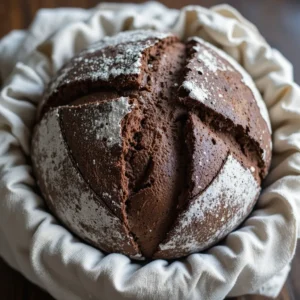 If you have nut or dairy allergies, remember to double-check your chocolate and optional ingredient labels. Always consult a healthcare professional if you have any specific dietary concerns.
If you have nut or dairy allergies, remember to double-check your chocolate and optional ingredient labels. Always consult a healthcare professional if you have any specific dietary concerns.Key Takeaways
- Flavorful Fermentation: The tang of sourdough complements cocoa’s rich taste.
- Customize Freely: Add-ins like chocolate chips, nuts, fruit, or a swirl of peanut butter can radically transform your loaf.
- Proper Fermentation: A healthy, active starter is crucial for good rise and texture.
- Flexible Serving Options: Works for sweet breakfasts, savory snacks, or indulgent desserts.
- Store It Right: Keep your loaf fresh by wrapping it properly, or freeze slices for easy reheating later.
FAQs
Is chocolate sourdough bread good?
Absolutely! The gentle acidity of sourdough pairs beautifully with the richness of cocoa, creating a balanced flavor that’s both sweet and tangy. You can enjoy it toasted with your favorite spreads or as the base for a decadent dessert.
How does cocoa powder affect sourdough?
Cocoa powder adds color and a mildly bittersweet note, altering the bread’s overall taste and aroma. It can also increase the dough’s density if too much is used, so it’s best to adjust the hydration level to maintain a soft crumb.
Does chocolate sourdough take longer to bulk ferment?
Generally, the addition of cocoa doesn’t significantly lengthen fermentation time—temperature and starter health are more decisive factors. However, in cooler environments or if your starter is less active, you may experience a slightly slower rise.
What is the disadvantage of sourdough bread?
While sourdough can be easier on digestion for many people compared to commercial breads, it still contains gluten. Individuals with celiac disease or severe gluten sensitivities may need a fully gluten-free option. Also, sourdough requires patience and time for feeding and fermentation.
Why do people prefer sourdough?
Many enjoy its complex flavor, chewy texture, and potential health benefits from natural fermentation. Plus, the satisfaction of maintaining a starter and creating artisanal bread at home is a big draw for baking enthusiasts.
Does cocoa powder affect yeast?
Cocoa powder itself won’t kill the yeast, but it can make the dough slightly thicker and a bit more challenging to rise. Ensuring your starter is active and adjusting hydration will help the dough ferment effectively.
Conclusion
Baking a fresh loaf of chocolate-infused sourdough is more than just making bread—it’s about adding a bit of delicious indulgence to your day. The tangy, fermented base combined with velvety cocoa creates a loaf that’s unique, comforting, and absolutely share-worthy. I hope this recipe brings joy to your kitchen and sparks your creativity. If you give it a try, let me know how it turns out—I’d love to hear your story and see how you’ve made it your own!

